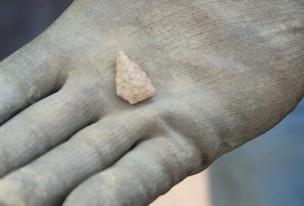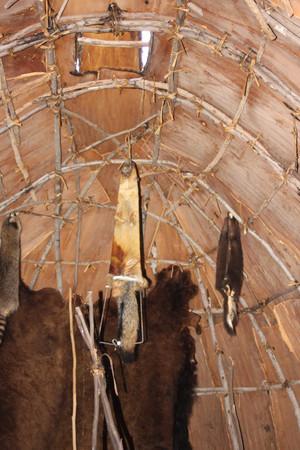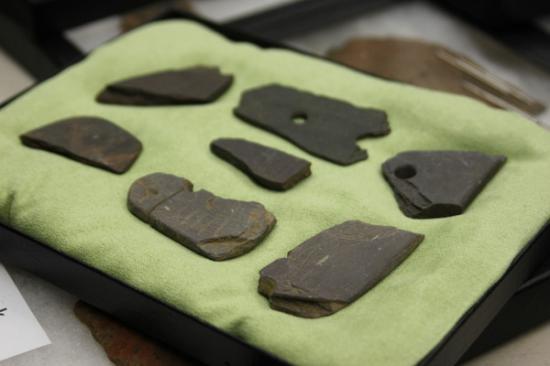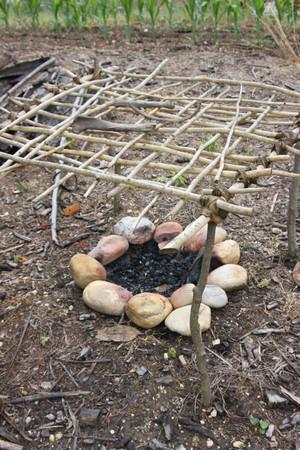Pig Point Artifacts May be Helping to Re-Write History
A look at some of the most interesting items found and archaeologists explain why they are finding many things in unexpected places.
David Pecor
Source - http://edgewater.patch.com/articles/part-ii-pig-point-artifacts-may-be-helping-to-re-write-history
To archaeologists, every artifact tells a story. Even some of the smallest items found can tell archaeologists a lot about how the people may have lived during that time period. The discoveries at the Lothian's Pig Point archaeological dig site have been providing fodder for all kinds of interesting stories about how the many people who have occupied this location for thousands of years may have lived their lives. A projectile point made from Ohio stone found the first year has leader of the dig and chief archaeologist for Anne Arundel county, Dr. Al Luckenbach, theorizing that perhaps the Hopewell tribe of that area may have traded with the Algonquin tribes that inhabited this site just a few hundred years ago—a relationship that was not previously thought to exist. “All of a sudden we’re getting these little pulses, these clues all over the place here that there’s some kind of connection between here and the mound building cultures of Ohio and that’s kind of revolutionary for Maryland,” he said.

This Madison style projectile point is made of quartzite and likely dates back to somewhere between 800 C.E. and 1800 C.E. Credit: David Pecor
Another interesting element to this site are the apparent abundance of wigwams, or early shelters made by Native Americans throughout the area, that once stood here. Today the only evidence archaeologists find are small circular stains in the soil were a sapling had been drove into the ground to support the structure. What is so interesting about the evidence of wigwams at Pig Point said Luckenbach is that they find evidence for them further back in time than they would have expected.

A view from inside a wigwam recently constructed near the dig site by the property owner William Brown. Anne Arundel County archeologist Dr. Al Luckenbach explained that the only evidence of these structures that remains today are small stains in the soil arranged in an oval pattern where saplings were drove into the ground as a support frame. Credit David Pecor
“When we first found them we knew they were from the 1300’s, and they’ve only ever seen this [wigwams] two other times in Maryland and both of those were from the 1400‘s,” he said. Luckenbach explained that as they continued to explore the site the evidence of wigwams continued to appear in the layers of soil called stratographic layers, or ‘strats’ for short. “As we dug down through these strats, we still kept finding wigwams,” he said. “We were able to date one to 520 AD and another one came back 210 AD.”
Another interesting find at the site are the gorgets, pieces of ancient decorative necklaces. “The necklaces are made from stone found in the mountains in what is today Frederick County,” said Luckenbach. “They would occasionally decorate them so they were important things,” he said. “We keep finding broken ones up here, a bunch of them. What we’re finding is that after they’re broken they’re marking little designs on them and then tossing them.”

These 'gorgets' are sections of an ancient decorative necklace. Many of these artifacts have been found at the site and archeologists are still unsure of their signifigance to the people who made them. Credit: David Pecor
He said it is very difficult to determine exactly what these marking mean but he believes they are significant. "One theory would say that it's just doodling,” he said. “But another theory would say this thing had power to them, it was an important object and when it’s broken you can’t just throw it away.”
Much of the work is speculative, but he believes the artifacts had some kind of significance to the people living here and it is just another of the sites mysteries. “That’s one of those things where there trying to tell us something and we’re not quite sure what it is,” he said. “None of them seem to be from the same thing, they’re all different,” said archaeologist Jessie Grow who was also perplexed by what the discovery tells us about the people living at the site thousands of years ago.
Many of the artifacts discovered here are pottery shards, or in a few lucky cases, a complete pot. One style of pot looks like a small painters cup made from a ball of clay that was fired by burying it in smoldering embers. One such pot was discovered completely undisturbed leading the archaeologists to believe it was never removed from the ground after being put there to cure.

This replica of a fire pit is a wonderful find for an archeologist as many of them contain things like food scraps, broken pottery and other personal effects that can all be associated with the same period of time. Credit: David Pecor
“Finding this pot exactly where they made it and it had never even been used because it had never been pulled out of the ashes,” said Luckenbach.
Grow explained that there were clues in the surrounding soil that lead them to believe the pot was never actually used. “In that same area we found fire rings where it looked like there may have been others being made and maybe they just forgot about this one,” she said. Grow said they are not usually so lucky to find a piece of pottery that is completely intact. Most of the pottery is broken into small pieces and must be painstakingly put back together in the lab. “It’s like taking a hundred jigsaw puzzles and removing 75 percent of each piece and then trying to put them all back together,” she said. She also said they have also found tiny pots that are highly decorated. They are not sure what that means but it’s not likely a functional piece. “Unfortunately this one came from a section of disturbed area so we don’t know exactly what time period it comes from,” she said. “But this is just a tiny sample of what we have, we have tens of thousands of archives from this site,”

CIV.106 - 206 : Civilisations paléo-indiennes / Amerindians of North America
Projectile Points are another common discovery at the site and these have yielded interesting results as well. Grow explained that where they are finding these points in proving to be highly significant. “Triangle points are typically considered to be arrowheads but we’re finding them way farther down than the arrow was supposed to be invented,” she said. “Either they had the arrow much earlier than we originally thought, or they we’re using triangle points for spear tips as well.”
Fire pits can be very valuable to archaeologists because they contain a large amount of artifacts that are clearly all associated with a single time period. Archaeologist Steve Tourville found a fire pit with several different waste items contained inside along with the charcoal. From fish bones, freshwater mussels charred hickory nuts to stone chips from tool making and pottery shards, these collections tell us a lot about the people who lived there. That particular pit dated back 8500 years ago said Tourville. “It’s cool finding a date that old but it’s much more important finding it in such good context” he said. “We can associate all that stuff with 8,500 years ago.”
Grow added that the most significant artifacts may still be waiting for them to discover. “There are still a lot of questions that are yet to be answered here,” she said.